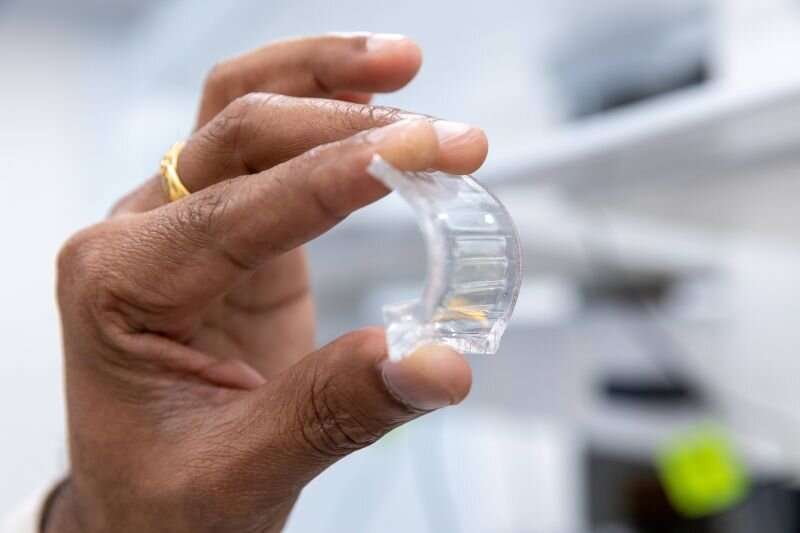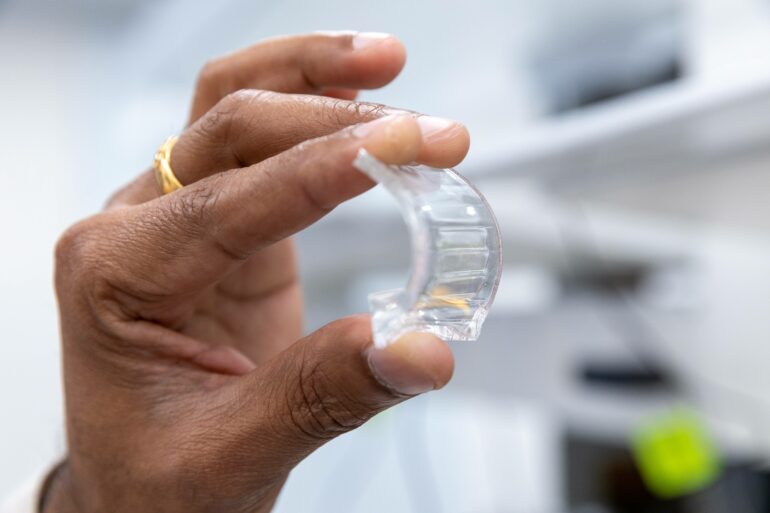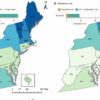The world’s first flexible, transparent augmented reality (AR) display screen using 3D printing and low-cost materials has been created by researchers at the University of Melbourne, KDH Design Corporation and the Melbourne Centre for Nanofabrication (MCN). The development of the new display screen is set to advance how AR is used across a wide range of industries and applications.
AR technology overlays digital content onto the real world, enhancing the user’s real-time perception and interaction with their environment. Until now, creating flexible AR technology that can adjust to different angles of light sources has been a challenge, as current mainstream AR manufacturing uses glass substrates, which must undergo photomasking, lamination, cutting, or etching microstructure patterns. These time-consuming processes are expensive, have a poor yield rate and are difficult to seamlessly integrate with product appearance designs.
Led by University of Melbourne researchers Associate Professor Ranjith Unnithan, Professor Christina Lim and Professor Thas Nirmalathas, in collaboration with Taiwanese KDH Design Corporation, the team has successfully developed a transparent AR display screen using low-cost, optical-quality polymer and plastic—a first-of-its-kind achievement in the field of AR displays.
The team used additive manufacturing techniques, also known as 3D printing, in the fabrication process, making it a pioneering approach in the field of AR displays. KDH Design Corporation manufactures AR motorbike helmets and military goggles and will integrate this new technology into the visor of head-worn devices, such as AR glasses, AR sports goggles and AR helmet and automotive displays.
The display screen is flexible and versatile, and can bend and fit different shapes, like curved or uneven surfaces that give a designer more freedom to fit a product form factor. The display screen is transparent, providing users with a natural and unobstructed view, while overlaying digital content.
Additionally, the additive manufacturing techniques allow for precise control over design and production, resulting in higher quality products, and the potential for cost-effective and scalable mass manufacturing that will make the technology more accessible and affordable for a wider range of applications.
Associate Professor Ranjith Unnithan said this represents a breakthrough in the field of AR technology and the potential applications are vast.
“In the gaming industry, flexible and transparent AR displays could be integrated into gaming accessories such as goggles or visors, providing a more immersive and realistic gaming experience,” Associate Professor Unnithan said.

The flexible, transparent polymer-based material will advance how AR is used across a range of industries. © Cesar Nicolas
“In education, AR displays could be incorporated into educational tools and simulations, allowing for interactive and engaging learning experiences. In healthcare, AR displays could be used in medical training, assisting surgeons with real-time information during operations, but there are many other potential applications, from transport to tourism.”
KDH Design Corporation CEO Jeremy Lu, a University of Melbourne alumnus, said the breakthrough was achieved after four years of collaborative research.
“The ultimate AR technology we had in mind, based on our research, had to be very thin, very power efficient and very light, so we can adapt the AR ‘film’ for near-eye applications, such as AR glasses and goggles. We also wanted to be able to use the AR technology for transparent displays, for example, in car windscreens,” Jeremy Lu said.
KDH Corporation CTO Younger Liang said KDH’s collaboration with University and Melbourne researchers enabled the company to develop a prototype that realized KDH’s vision.
“We can now commercialize this technology for a wide range of new and exciting applications,” Younger Liang said.
Professor Nicolas Voelcker, Scientific Director, Melbourne Centre for Nanofabrication, said his team were excited to collaborate with KDH Design Corporation and the University of Melbourne to “support their efforts to develop new flexible materials for augmented reality displays.”
“The MCN is a world-class nanofabrication center, combining cutting-edge technologies with the knowledge and skills of expert process engineers,” Professor Voelcker said.
The intellectual property and patents for this research are owned by KDH Design Corporation, a research collaborator of the University of Melbourne since 2019, and both are eager to continue collaborating on future research. Patents have been filed in the United States of America and the new technology is now ready for mass production.
Provided by
University of Melbourne
Citation:
New transparent augmented reality display opens possibilities to see digital content in real-time (2023, May 17)



